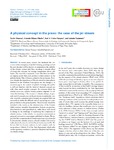Mostrar o rexistro simple do ítem
A physical concept in the press: the case of the jet stream
| dc.contributor.author | Fonseca, Xavier | |
| dc.contributor.author | Míguez-Macho, Gonzalo | |
| dc.contributor.author | Cortés Vázquez, José Antonio | |
| dc.date.accessioned | 2022-09-05T14:12:25Z | |
| dc.date.available | 2022-09-05T14:12:25Z | |
| dc.date.issued | 2022 | |
| dc.identifier.citation | Fonseca, X., Miguez-Macho, G., Cortes-Vazquez, J. A., and Vaamonde, A.: A physical concept in the press: the case of the jet stream, Geosci. Commun., 5, 177–188, https://doi.org/10.5194/gc-5-177-2022, 2022 | es_ES |
| dc.identifier.issn | 2569-7110 | |
| dc.identifier.uri | http://hdl.handle.net/2183/31488 | |
| dc.description.abstract | [Abstract] In recent years, science has hardened the discourse on the emergency of global warming, pointing out that the next decades will be decisive to maintaining the stability of the climate system and, thus, avoiding a cascade effect of events that increase the average temperature above safe limits. The scientific community warns that there are different tipping points that could produce a chain reaction in the global climate. One of them is related to the jet stream. However, despite the importance of this air current in atmospheric dynamics in the Northern Hemisphere and the changes it is experiencing in the context of global warming, the public is still not familiar with this kind of physical concept nor with other much simpler concepts. As concerns about the climate crisis rise, climate literacy remains stagnant. To advance the learning of the science of climate change, in general, and of concepts such as the jet stream, in particular, specific scientific communication formats are required that can successfully tackle the difficult task of explaining such complex problems to the general public. These formats should be included in the media, as the characteristics of the formats (daily section, scientific dissemination, historic perspective, teleconnections and specialization) make them well suited to taking on the challenge of explaining the complexity of climate science. In this article, we present a communication proposal existent in a newspaper published in Spain. We argue that this communication format represents a good model to disseminate climate science, educate readers and even to make physical concepts such as the jet stream accessible. We believe that this format conforms to and complies with the enunciation of Article 12 of the Paris Agreement, which calls on the signatory countries to promote education and training on climate change. | es_ES |
| dc.language.iso | eng | es_ES |
| dc.publisher | Copernicus Publications | es_ES |
| dc.relation.uri | https://doi.org/10.5194/gc-5-177-2022 | es_ES |
| dc.rights | Licencia Creative Commons Attribution 4.0 (CC-BY 4.0) | es_ES |
| dc.rights.uri | http://creativecommons.org/licenses/by/3.0/es/ | * |
| dc.title | A physical concept in the press: the case of the jet stream | es_ES |
| dc.type | info:eu-repo/semantics/article | es_ES |
| dc.rights.access | info:eu-repo/semantics/openAccess | es_ES |
| UDC.journalTitle | Geoscience Communication | es_ES |
| UDC.volume | 5 | es_ES |
| UDC.issue | 3 | es_ES |
| UDC.startPage | 177 | es_ES |
| UDC.endPage | 188 | es_ES |
Ficheiros no ítem
Este ítem aparece na(s) seguinte(s) colección(s)
-
GI-GET - Artigos [76]






